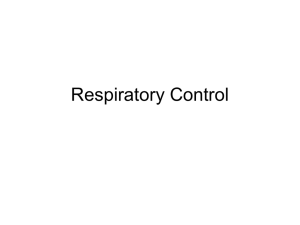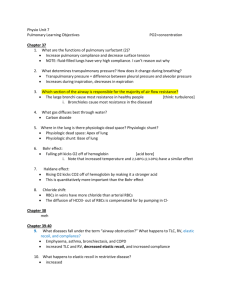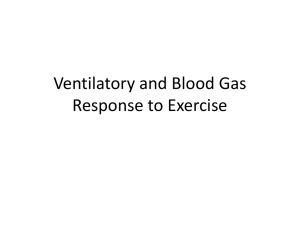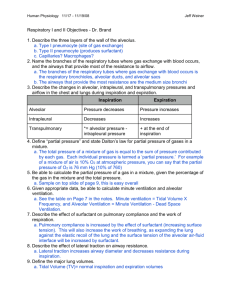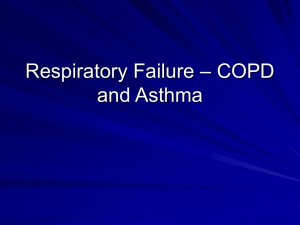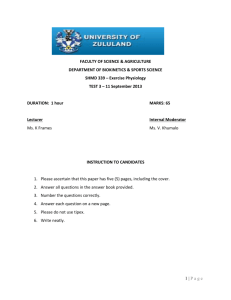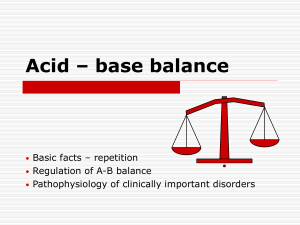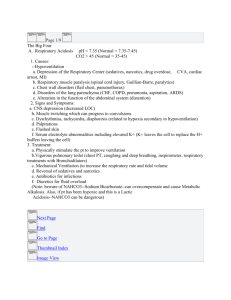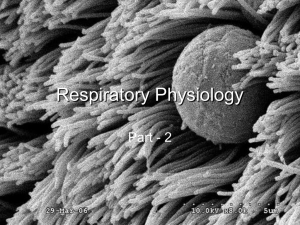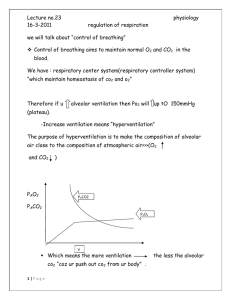lect 23 Resp 4
advertisement
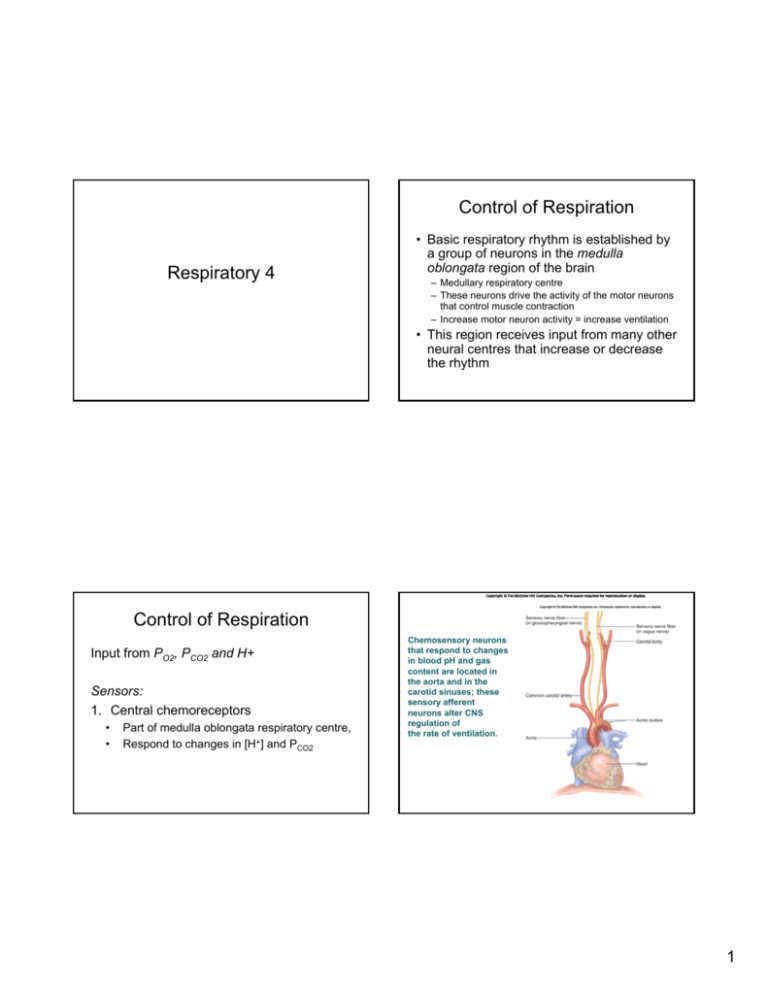
Control of Respiration Respiratory 4 • Basic respiratory rhythm is established by a group of neurons in the medulla oblongata region of the brain – Medullary respiratory centre – These neurons drive the activity of the motor neurons that control muscle contraction – Increase motor neuron activity = increase ventilation • This region receives input from many other neural centres that increase or decrease the rhythm Control of Respiration Input from PO2, PCO2 and H+ Sensors: 1. Central chemoreceptors • • Part of medulla oblongata respiratory centre, Respond to changes in [H+] and PCO2 Chemosensory neurons that respond to changes in blood pH and gas content are located in the aorta and in the carotid sinuses; these sensory afferent neurons alter CNS regulation of the rate of ventilation. 1 PO2 and ventilation ↓ Inspired PO2 ↓ alveolar PO2 ↓ arterial PO2 ↑ Activity of peripheral chemoreceptor ↑ Contraction of respiratory muscles ↑ ventilation A decrease in PO2 stimulates an increase in ventilation CO2 and ventilation CO2 + H 2O R H 2CO3 R H + + HCO3− ↑ Alveolar & arterial PO2 CO2 and ventilation • Increased PCO2 drives increased breathing If PCO2 is high this reaction proceeds to the right •increasing ventilation decreases PCO2 & brings this reaction back to the left • Very sensitive – even small changes on CO2 will effect breathing frequency 2 ↑ arterial PCO2 ↑ arterial [H+] ↑ brain PCO2 ↑ brain [H+] ↑ Activity of peripheral chemoreceptor ↑ Activity of central chemoreceptor ↑ Contraction of respiratory muscles This is important because CO2 can cross the bloodbrain barrier, but H+ can not H+ changes not related to CO2 • Metabolic acidosis/alkalosis – Ingestion of acid – Lactic acid production – Vomiting (loss of acid) • Only through peripheral chemoreceptor ↑ ventilation return alveolar & arterial PCO2 to normal Return arterial and brain [H+] to normal ↑ Production of acid How does central chemoreceptor work? ↑ Arterial H+ ↑ Activity of peripheral chemoreceptor ↑ ventilation CO2 CO2 HCO3- + H+ ?? T ↑ Contraction of respiratory muscles Chemoreceptor neuron CO2↔H2CO3 K+ Ca++ depolarization Calcium increases neurotransmission ↓ alveolar PCO2 ↓ arterial PCO2 return H+ toward normal second neuron Output to respiratory control centre, ↑ breathing 3 • Exercise – The increase in ventilation during exercise is not easily explained by O2, CO2 regulation – Exercise • • • • increased O2 consumption and CO2 production But these changes are in the venous, not the arterial blood During moderate exercise arterial PO2 and PCO2 are normal Receptors are measuring arterial blood – Other factors: • • • • • Increase in H+ during strenuous exercise Input from motor cortex of brain to respiratory centre Receptors from muscles and joints Epinephrine Body temperature The End • • • Longer term acclimatization: eg high altitude is like chronic hypoxia Since Patm goes down, PO2 goes down – – Initial responses the same as acute hypoxia Longer term changes include: 1. 2. 3. 4. Increased red blood cell production Shift in Hb saturation curve to unload more O2 Increased capillary density to increase delivery Decreased plasma volume (increases Hb concentration) Exam Structure Saturday Dec 16, 4-7 pm CC1080 5 written questions 21 multiple choice 3 hour time slot You do not need a calculator 4 What you need to know for the final • Office hours: – Thursday 1-2pm - class is cancelled – I am usually on campus – NOT here Friday Dec 10, or Friday Dec 15 – If you want to make sure to see me, email for an appointment – Email questions Renal (5 lectures) 1. Basic fluid stuff – distribution of fluid in the body 2. Renal Processing a) b) 3. 4. Formation of dilute and concentrated urine and regional differences in nephron tubules Control of Renal blood flow and GFR a) b) c) 5. autoregulation SNS Hormonal – AngII, ANP Sodium and Water a) b) c) d) 6. Filtration Reabsorption SNS – GFR & renin secretion Renin, AngII, aldosterone system ANP – multiple effects ADH – aquaporin channels Acid-Base a) b) Buffer systems: bicarbonate, phosphate, ammonia respiratory What you need to know for the final • What are the key variables? – Water – Na – Acid Respiratory (4 lectures) 1. Ventilation and mechanics of breathing a) b) c) d) e) 2. – Atrial stretch receptors – blood volume – Osmoreceptors – blood osmolarity – Macula densa – tubular osmolarity – Acid – chemoreceptors (respiratory) Gas exchange a) b) c) • What are the sensors? 3. Partial pressure of gas Driving pressures for gas exchange in alveoli and tissue Factors affecting alveolar gas pressure (Patm, ventilation, use/production by cells) Gas Transport a) b) 4. compliance Surface tension Resistance Lung volumes Alveolar ventilation Hb and Oxygen, saturation Carbon dioxide Controls a) b) c) P02 PCO2 H+ (acid-base balance) 5 • What are the key variables? – PO2 – PCO2 – Acid • What is the challenge? • Which sensors detect the challenge? • How do the sensors respond to a challenge? • What are the sensors? – Central Chemo – PCO2, H+ – Peripheral Chem - PO2, PCO2, H+ Questions you should know how to answer 1. How does the kidney produce concentrated (dilute) urine? 1. What is important about the different regions of the nephron? 2. What is the relationship between sodium and water? How does the kidney handle sodium and water? 1. How does the system respond to: 1. Increased (decreased) water volume? 2. Increased (decreased) sodium concentration 3. How does the kidney contribute to acid balance? • Remember the physiology is always set up to bring the variables back toward normal Questions you should know how to answer 1. What is the relationship between compliance, surface tension, and ventilation? • 2. 3. 4. • 5. What happens if compliance or surface tension go up (down) What is the relationship between ventilation and alveolar gas pressure? What is the relationship between blood flow and airflow in the alveoli? How are gases transported in the blood What is the role of hemoglobin? How does the respiratory system respond to increased (decreased) PO2, PCO2, H+? 6
